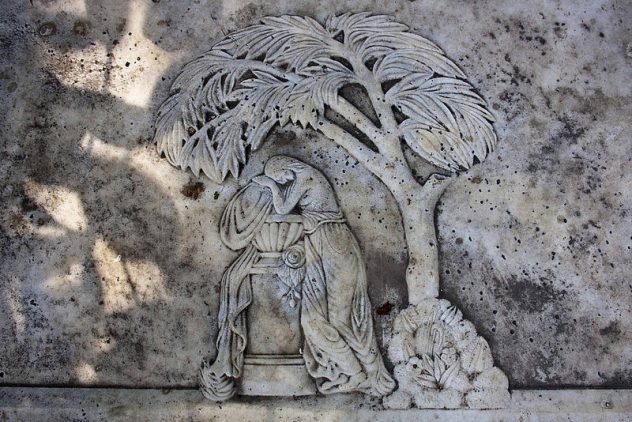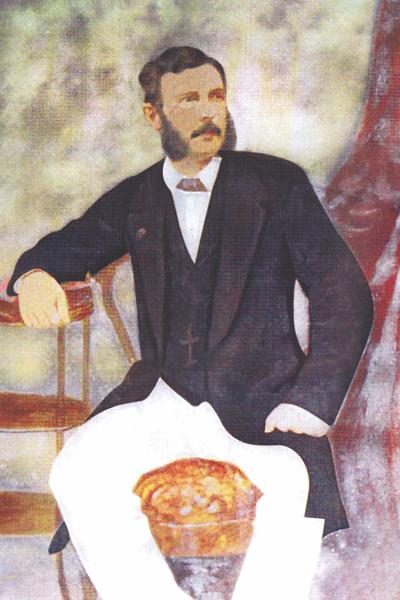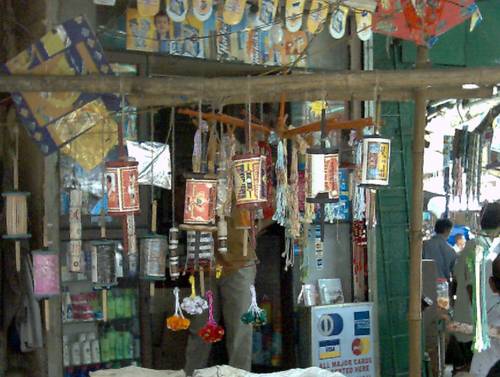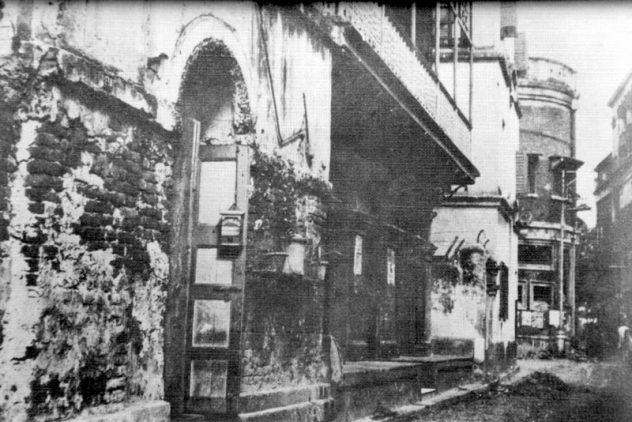William Martin Sarkies was seventeen years old and fond of flying kites. Urban kite flying had been popularized under the muslim monarchs of northern and eastern South Asia, including old Bengali cities such as Dhaka, Murshidabad, etc. Calcutta, though it was a colonial city lacking in the rich pedigree of cities like Dhaka and Murshidabad, had quickly absorbed the culture of urban kite flying. Much like kite flying, the Armenian community, to which Sarkies belonged, predated the rise of British power and Calcutta. They had served the Nawabs of Mughal and post-Mughal Bengal as merchants and military men. Indeed, the man entrusted with Nawab Mir Qasim’s guns at the fateful battle in Baksar (Buxar) was an Armenian named Khojah Gregory or Gorgin Khan.
Whatever might have been the precolonial pasts of kite flying or the Armenian community, by the 1870s they were both an indelible part of the rich social and cultural fabric of Calcutta. Along with many other young men, William was thus regularly to be seen at the Wellington Square flying kites on late afternoons. His regular companion on these sojourns was an Eurasian lad named Godfrey. Tuesday, the 4th of August 1874, was no different. William and Godfrey had already been flying kites for a while and the sun was kissing the top of the western horizon.
Unbeknownst to William, Peary Charan Dass, had also walked to Wellington Square that evening to fly kites. Peary and William were next-door neighbors on Creek Row, and both shared a love for kites. Both also came from affluent families. William’s father was a wealthy merchant, while Peary’s was a rich landlord holding land in Sylhet. Yet the two had never been close.
Eyes firmly fixed on the firmament, watching their kites, they gradually drifted next to each other. It was perhaps fate that guided their feet. However it came to pass, at one point the two boys found themselves side by side. What happened next remains a matter of serious dispute. According to one version of events, the two neighbors bumped into each other and William disdainfully addressed Peary using a racial slur. According to another version, Peary was the first to comment and made some sarcastic comment about the dirty clothes William was wearing. Yet a third, and possibly more likely version, stated that the two had initially started chatting casually but at some point a quarrel arose.
Once the quarrel broke out, William struck Peary with a cane he was carrying. Peary fell to the ground, even as William struck a second blow. Godfrey apparently looked on unsure of what to do. An enraged Peary now fished out a pen-knife from his pocket and went on the counter-attack. William tried to defend himself, but Peary now cut William on his arm. As he dropped his cane, Peary lunged forward and stabbed him in the armpit. Finally, and before either party really knew what was going on, Peary slashed William’s throat with the penknife. William now staggered back and collapsed. A crowd began to gather and Peary, realizing for the first time how far he had gone, dropped the knife and ran. Bleeding profusely and barely able to speak, William managed to implore Godfrey to ensure that Peary is punished for his crime, before quickly passing away.
By this time a large crowd had gathered around the dead boy and his stunned friend. The local police arrived shortly. Sometime later, William’s grieving father appeared on the scene. But the tragedy was not over. Even as a police inspector stood guard waiting for the investigation at the scene to be completed, somehow the whole episode acquired a racial connotation. The crowd, one European newspaper later alleged, began to taunt the grieving father even as he sat next to his departed son. Native newspapers did not comment directly on the crowd behavior, but repeatedly asserted that William had been a bit of a lout, prone to making racially charged remarks and getting into fights. This may have motivated the obscene reaction of the crowd, if indeed it took place. To confound matters further, at some point in the evening, the European police officer standing guard deliberately moved away to allow a small band of European men to take on the jeering crowd. What followed was a minor race riot.
In the meantime, another police team accompanied by Godfrey embarked upon a pursuit to arrest Peary. By all accounts, the ghastly murder notwithstanding, Peary was an otherwise respectable lad. He was slightly older than his unfortunate victim. After initially studying for law and medicine for awhile, he quit college to take up a job at the Foreign Office. He did not seem like the hardened criminal who would run from the law and indeed he did not. Superintendent Younan and Inspector Moriarty arrested him without much trouble around 11pm on the same night at the house of one of his friends at Sakaritollah Lane.
The racial riots that had broken out at the murder scene now began to color public opinion on the case. Even as Peary was sent to trial at the next Criminal Sessions, newspapers throughout the length and breadth of the British Raj joined the fray for or against Peary. Newspapers such as the Madras Mail and the Delhi Gazette took an anti-Peary stance, while Amrita Bazar Patrika took a pro-Peary position.
On both sides of the divide, the victim’s racial liminality became a key issue in an increasingly polarized colonial milieu. In the best tradition of yellow journalism, as tempers flared and passions were inflamed, lurid racist rhetoric bubbled up like putrid sewage on both sides. The pro-European papers shrieked that “the Bengalee”, being “ninety parts a coward and ten parts bluster”, had neither the right nor the justification for raising his hand against a “semi-white man”. The pro-Indian papers by contrast countered that even if “the Bengalee” was forced to accept daily insults from the Briton, who was after all the ruling race, he could not be expected to stand the “haughty airs of the Feringhees and the Armenians”. Indeed, one native paper went so far as to justify the murder of William in the name of “putting down a jackal that insisted on playing lion”.
On both sides there were more tempered voices too. One argument for Peary was that his past record of good behavior and his current state of utter distraction following the murder showed that the death was more an accident than a deliberate murder. Similarly, a sober argument against him was that young lads were often prone to verbal insults and quarrels that were frequent on the playgrounds of public schools, and so if boys started stabbing one another on such issues it would lead to utter chaos.
Peary’s father naturally recruited some of the best defense lawyers for the case. Barristers Evans, Branson and CC Dutt constituted a formidable defense team. The lawyers predictably argued that the murder was unpremeditated, provoked by the victim himself, and eventually committed in self-defense against an assault commenced by the victim. Numerous witnesses were brought forward to attest to both William’s quarrelsome disposition and the fact that it was he who had commenced the physical assault. The prosecution had eventually chosen to put Peary up for four counts of ‘culpable homicide’ rather than ‘murder’. The jury acquitted Peary on three counts of culpable homicide and chose instead to find him guilty of the lesser charge of ‘causing grievous hurt’. The jury also recommended leniency in sentencing in view of what they said was extreme provocation. Justice Markby, concurring, passed a light sentence of three months of rigorous imprisonment.
The public reception of the judgment was predictably as divisive as the trial had been. Some denounced it as an utter miscarriage of justice, whilst others hailed it as a recognition of native rights against racial insults. Yet the case was soon drowned in the proverbial shadows of the gaslit world and Peary and William both eclipsed from public view.
Distant as Peary and William’s world seems today, in its lurid and gory hues we can already catch glimpses of our present world. The increasingly hardening racial lines, for instance, seem closer to our world than the world where Khojah Gregory controlled the Nawab’s cavalry. The jingoistic nationalism sounds entirely relatable. The scapegoating of minority groups as stand-ins for anti-colonial rage that cannot be openly articulated seem to anticipate the anti-Islamism of Bankimchandra’s novels around the same time. The construction of free-floating communal identities by abstracting unfortunate, localized incidents of polysemic violence out of context likewise seem to anticipate the communal riots of colonial and postcolonial South Asia. Most strikingly, the formation of mediated partial publics and their often mutually unrecognizable ‘alternate realities’ seem to resonate entirely with our times.
In looking back at the tragic fate within which both William and Peary, and perhaps Godfrey too, was caught, it is not the death that I lament most. Young boys have always been rash and will continue to be so. There will be a certain amount of violence and, tragic as it is, death too. But it is the obscenity of crowds jeering at a grieving father and the vulgar, media-fueled rage that deprives us of the capacity to mourn a loss unless it is “one of our own”, that saddens me. It saddens me even more that in the disgusting communalization of William’s death, people lost sight of the vibrant mixed neighborhoods such as Creek Row where Armenians, Eurasians and Hindus had lived side by side as next door neighbors.
In fact, my own family had lived in the same neighborhood at the time. Some of them continue to live there till this day. I wonder what my great-great-grandfather who would have been their contemporary had thought of William or Peary? Had he too flown kites with them? How had the neighborhood reacted in the wake of the divisive trial? Had they consoled William’s father or had they been busy organizing Peary’s defense?
I also wonder about Peary. He may not have been close to William but they were neighbors and had grown up side by side. How did he live with his guilt? During the trial, most papers hinted at his genuine contrition. How did he face up to the blood on his hands when he got back home after his three months in prison? Could he ever forgive himself for his temper? I wonder too if the Sarkies family continued to live on Creek Row. Or did they move away? If they lived on, how did they bear the sight of the man whose hands were stained by their son’s blood?
Unfortunately, most of the Williams and the Godfreys in the neighborhood have long since disappeared. But reassuringly, kites still fly and, more menacingly, young lads continue to fight over kites in Calcutta. Therein perhaps resides both the hope and the despair of the Calcutta that lives on in the shadow of the Calcutta that once was.








that is great post thanks
very helpful article
great article thanks for sharing
Thanks
very helpful
Thanks for this beatiful information